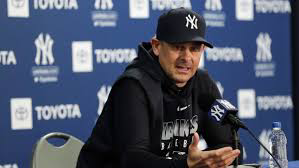
Introduction: A Promising Addition to the NY Yankees Roster
The New York Yankees are looking to bolster their infield depth, and they’ve set their sights on a fresh, promising talent: Kaeden Kent. The Yankees, seeking both long-term upgrades and internal options, recently finalized a significant signing with this young prospect. According to MLB.com’s Jim Callis, Kent, who the team chose in the third round of the draft, inked a lucrative deal valued at $744,400, aligning precisely with the slot value assigned to his draft pick.
Draft-Day Selection: Where Kent Came From
On draft night, the Yankees held multiple selections but were particularly excited about the one at 103rd overall, which they used to select Kaeden Kent. This was their second selection in that round. Kaeden’s lineage is hard to ignore: he is the son of Jeff Kent, the National League MVP in 2000, and a long-time Major League infielder known for a stellar career. Betting on bloodlines in baseball is not uncommon, especially when they come with a strong pedigree and a proven college track record.

College Career: Performance at Texas A&M
Kent came to the Yankees from Texas A&M, where he played for three seasons. He showed consistent offensive production and positional versatility, logging a slash line of:
.290 batting average (BA)
.389 on-base percentage (OBP)
.494 slugging percentage (SLG)
He managed to deliver significant power and run-production over those seasons:
18 home runs
100 runs batted in (RBIs)
All accrued over a span of 135 games.
Those figures reflect well-rounded hitting—showing he can get on base, hit for average, and drive balls with authority. This all adds depth to his potential profile and makes him a compelling addition to the Yankees’ farm system.
Projected Value: MLB Prospect Rankings
Independent of the Yankees’ assessments, FanGraphs, a respected baseball analytics and scouting site, placed Kent at #102 among all prospects in this year’s draft class. That ranking underscores the value seen in his combination of hitting ability, power, and defensive skills. It aligns well with the Yankees’ own expectations, especially given that they used their second-round pick on him.
Yankees’ Financial Approach: Full Slot Signing Despite Constraints
The Yankees operate under a somewhat unique financial constraint in the baseball draft: they possess the smallest bonus pool in the league. Yet, despite that limitation, the front office opted to give Kent the full slot value—$744,400—for the 103rd pick. That’s a strong signal of intent, showing they believe Kent is worth investing in without squeezing his contract to save money for other picks. It indicates confidence in his future impact and value to the organization.
Rationale: Why the Yankees Covet Infield Versatility
One significant reason that Kent appeals to the Yankees is his ability to play multiple infield positions. Versatility has been a pressing need on the current Yankees roster. Their regular shortstop, Anthony Volpe, has had difficulties offensively and defensively this season. Volpe’s inconsistent play has stirred debate among fans about whether he should be demoted or replaced, at least in the short term.
To manage this situation, the Yankees have made a few roster adjustments already:
They shifted Jazz Chisholm Jr. from shortstop back to second base. Chisholm had been playing the position earlier but was moved back to stabilize the infield.
They also made the decision to bench veteran infielder DJ LeMahieu. As things progressed, LeMahieu was eventually designated for assignment (DFA)—a procedural move that opened his roster spot but perhaps signaled a pivot toward younger options.
These moves show a clear focus on shoring up their middle-infield defense and developing younger, more athletic talent. The signing of Kent fits neatly into this strategy, even if he won’t contribute immediately.
Looking Ahead: The Yankees’ Long-Term Plans
Though Kaeden Kent and his fellow new draftees aren’t positioned to jump straight to the big leagues, the Yankees are clearly planning with an eye toward the future. They understand that organizational depth—particularly in the middle infield—is critical for both daily lineups and playoff runs. Bringing in adaptable, college-seasoned players like Kent supports that objective.
By investing full slot money in Kent, the Yankees are messaging that they expect him to be a serious part of their long-term infield puzzle. With his pedigreed background, consistent performance, and defensive flexibility, Kent is a low-risk, possibly high-upside addition.
Expanded Context: Deficiency at Shortstop
To appreciate the move more fully, it’s useful to pause and look at where the Yankees stand defensively. Their current shortstop, Anthony Volpe, arrived with high expectations but has struggled to make his presence felt consistently. His offensive numbers have dipped below what the Yankees hoped for, and defensively he’s had moments of brilliance mixed with errors and inconsistencies. While Volpe still has considerable upside—after all, he’s young and talented—the team is understandably hedging by acquiring and developing alternatives.

Fans have begun to voice their concerns. Frustration with Volpe has spilled over, with some calling for less playing time, a stint in the minors, or a shift in position. Operating under pressure, the Yankees front office is likely balancing two priorities: giving Volpe enough time to grow into the role—he’s a highly touted prospect in his own right—while also mitigating risk by cultivating depth and competition.
Jazz Chisholm Jr. & DJ LeMahieu Moves: A Signpost
Shifting Jazz Chisholm Jr. back to second base reflects a more defensive-minded alignment. Chisholm, a dynamic athlete, had been giving shortstop a look. But by moving him back, the Yankees signal they want someone with more experience up the middle, even if that means sacrificing his offensive upside for improved defense.
The more symbolic move was benching—and then designating for assignment—DJ LeMahieu. LeMahieu has been a solid performer in past seasons and a familiar face in that infield. But benching him, then removing him from the 40-man roster, represents a serious commitment to exploring young options. It’s less of a temporary move and more of a structural shift.
The Draft Process & Bonus Pools
Most fans may not be aware, but MLB draft strategy is intricately tied to a team’s bonus pool—a cap on how much money a team can spend on signing bonuses without incurring penalties. The Yankees had the most limited pool this year, meaning they needed to be strategic. Selecting Kent at 103 and paying him slot value meant they were allocating a sizable chunk of their available resources to him, rather than cutting him a deal and diverting funds elsewhere.
That willingness speaks volumes: they see Kent as potentially roster-worthy—enough to forgo extra allotments elsewhere. In turn, that implies their evaluation grades him highly.
Breakdown of Kaeden Kent’s Profile
Let’s take a deeper look at what makes Kent interesting:
1. Hitting Ability
A career .290 batting average over three college seasons demonstrates consistency and contact skill—a good foundation for hitting at higher levels.
2. On-Base Skills
A .389 OBP indicates plate discipline and an ability to draw walks or identify strikes, adding value beyond just batting average.
3. Power Potential
With a .494 slugging percentage and 18 home runs across 135 games, Kent showed he could drive the ball to all fields—an underrated aspect for middle infielders.
4. Run Production
100 RBIs highlight that he can come through with opportunities in the clutch, another important skill in professional development.
5. Defensive Versatility
Although the original article doesn’t specify only shortstop, Kent played multiple infield roles at Texas A&M, giving the Yankees flexibility in how they deploy him.
6. Pedigree
Being the son of Jeff Kent, a former MVP and accomplished Major League infielder, adds not just genetic potential, but potentially also a maturity and understanding of the professional grind.
FanGraphs Ranking & Organizational Fit
FanGraphs ranked Kent as their 102nd overall prospect, positioning him right around the Yankees’ draft slot. Such recognition from third-party analytics adds credibility, especially since MLB clubs put varying degrees of stock in these public rankings.
That ranking serves as an objective check on the organization’s choice. It’s one thing for the Yankees to like him; it’s another for analytical sites to independently recognize his potential. Kent’s placement suggests he has both raw tools and polished skills that could make him a meaningful contributor down the line.
The Significance of Signing at Full Slot
Signing Kent for a full slot is a powerful gesture. It means:
The team values him highly.
They’re not holding back, despite budget limitations.
They want to secure him fully, signaling confidence in his development and future.
That contrasts with some teams that often sign picks for less than slot and use the savings to lure undrafted players or other signees. The Yankees decided Kent was too important to discount.
Timeline & Path Ahead
While Kent isn’t expected to break into the Yankees’ major league roster imminently, the signing starts the clock on his professional journey. He’ll likely enter the organization at a lower minor-league level—perhaps Single-A or High-A—to begin acclimating to pro ball.
From there, his climb would likely involve:
1. Showing he can maintain offensive production against more advanced pitching.
2. Demonstrating fielding proficiency at multiple positions.
3. Adjusting to the daily grind of a professional season—logistics, travel, mental toughness.
4. Progressing through the minor league tiers: Low-A → High-A → Double-A → Triple-A.
If he continues to develop, a potential arrival on the major league scene could come in a few years—depending on performance, roster need, and organizational speed.
Why It Matters to the Yankees
Here’s why Kent’s signing matters in the bigger picture:
Infielder Depth: The Yankees need more reliable backup options behind their starters.
Competition: Young talent pushes incumbent players to improve, which can elevate overall performance.
Insurance Policy: If Volpe continues to struggle, the Yankees have internal options without resorting to trades.
Organizational Continuity: With Kent in their system, the Yankees create a pipeline of talent ready to step in when called upon.
Other Picks & the Pipeline
Kent isn’t the only newcomer, but he’s one of the most intriguing. Though the article doesn’t list other picks, it notes that Kent’s deal is emblematic of a larger strategy: building a pipeline filled with versatile players who can fill various vacancies, strengthening the team from within over time.
Balancing Present Troubles with Future Hope
The Yankees currently dwell in a paradox: their name and heritage demand winning now, but they also must sustain their future over a potential decade. Anthony Volpe’s struggles reflect the tension between current performance and long-term growth. Adjustments like moving Chisholm or benching LeMahieu are reactionary steps, while developing Kent is proactive and planned.
Final Takeaway
By drafting Kaeden Kent with the 103rd pick and signing him to a full-slot contract of $744,400, the New York Yankees have signaled they believe in his ability to address some immediate weaknesses—particularly defensive reliability and infield coverage—and contribute meaningfully down the road. His track record at Texas A&M (.290/.389/.494 with 18 HR and 100 RBI in 135 games), his ranking among top-deal prospects by FanGraphs, and his off-field pedigree combine to make him a prospect worth watching.
Though he won’t be on the Bronx lineup card anytime soon, his signing reflects a broader—and largely positive—trend in the Yankees’ farm system strategy: investing thoughtfully, preparing for the future, and ensuring they have alternatives ready if the current core falters.
In summary: The Yankees have secured a highly promising college shortstop whose skills, parentage, and statistical performance make him a compelling future piece. They’ve backed that belief with a full-slot signing, even under a restrictive draft bonus cap. This move dovetails with a broader plan to shore up infield depth as they navigate a season marked by underperformance at key positions.
Leave a Reply